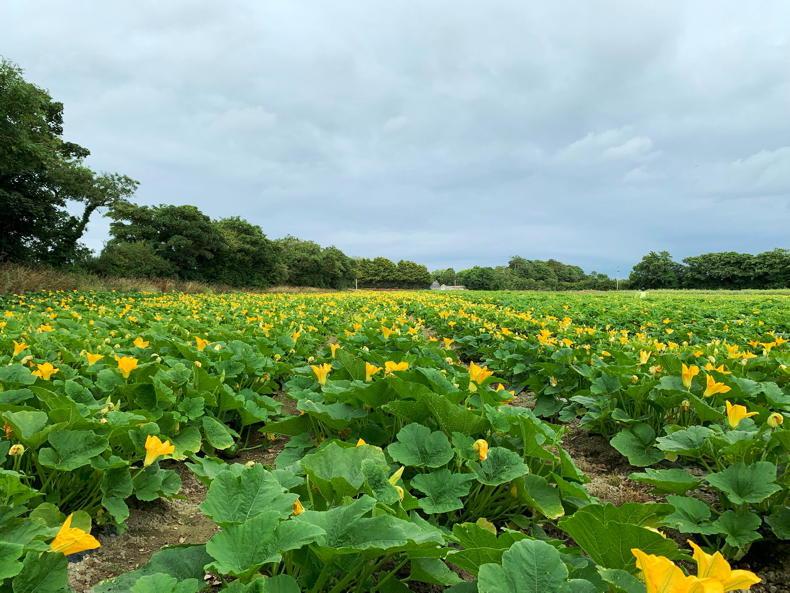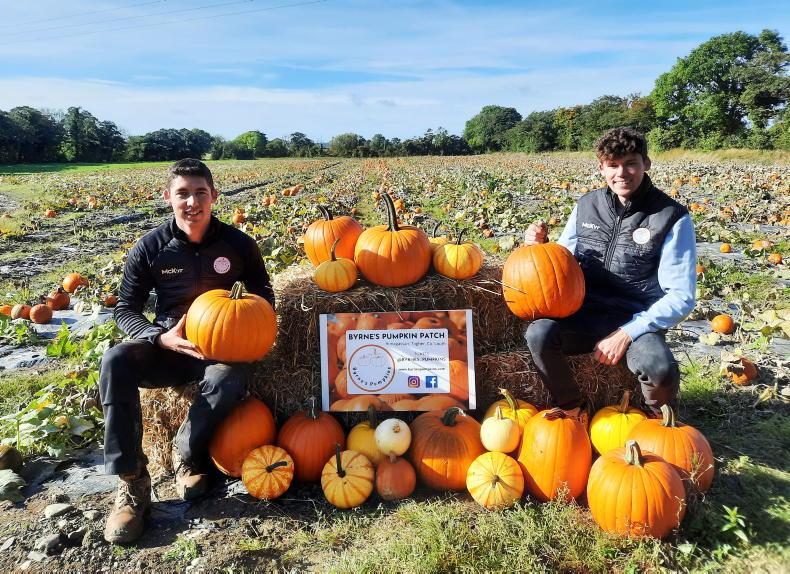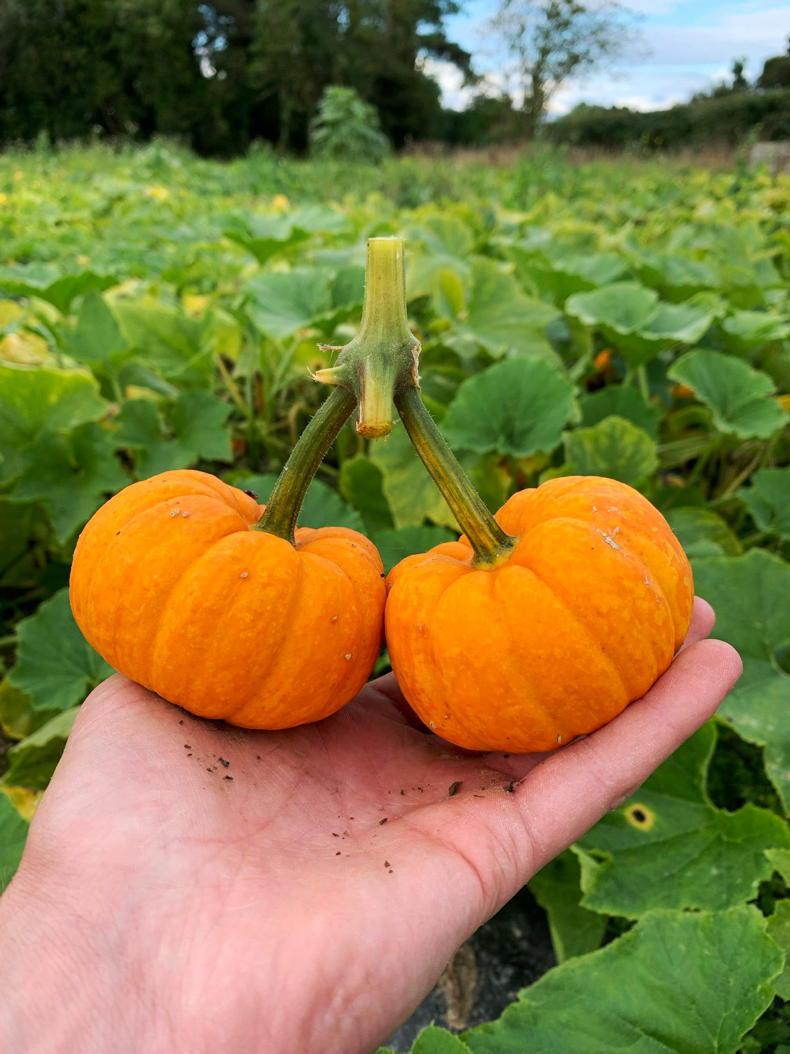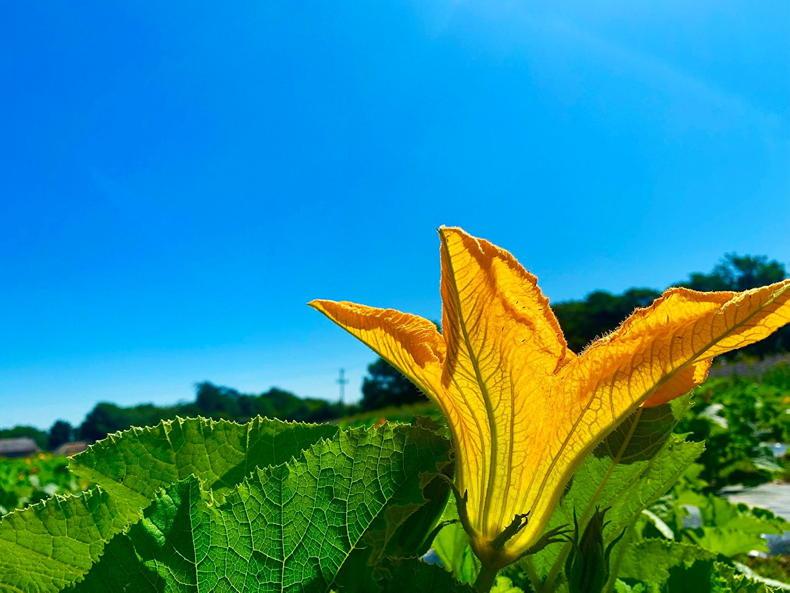This week, the Irish Farmers Journaltravelled to Co Louth to meet two of the most enthusiastic pumpkin growers in Ireland.
Not from a farm, twin brothers Micheál and Oisín Byrne from Togher in Co Louth now have a pumpkin farm, or a pumpkin factory as some might call it.
The brothers rent 4ac of land and grow approximately 15,000 pumpkins.
The Byrnes started growing commercially in 2018 and up until now they had been selling the pumpkins on, but in search of a better margin this season they have set up their own pumpkin patch, filled with different varieties, colours and shapes.
So where did it all start? The twins have been growing pumpkins since they were six years old, when their grandfather ran a competition between his grandchildren to see who could grow the biggest pumpkin.
Since then, not only have they won the family competitions but they’ve broken the Irish record a few times. In 2016, Micheál grew Ireland’s biggest ever pumpkin at 1,166.25lbs.
This was no mean feat. When you look around the 4ac patch, the hard work involved is evident. In April, seedbed preparation starts with stale seedbeds. Ground is ploughed and rotavated. May sees seeds planted in trays and, about a month later, 22,000 to 23,000 seedlings are planted out.
As the Byrnes are studying alongside farming, they plant in batches to spread the workload.

While the brothers have strong horticultural and farming connections they are not from a farm and so had to invest in a tractor.
They purchased a John Deere 3040 and their uncle, Brian Byrne, made them a planter when they started out.
They recently upgraded and the new planter places plastic on the ground and punches a hole for the seedling to come through. This suppresses the weeds and this season was the first time it was used.
Once the plants are hardy, they are watered and receive liquid feed. This contains seaweed, nitrogen, boron and amino acids. Biological products are also applied to keep diseases such as powdery mildew and different types of rots away.
Micheál knows all about these biologicals, which are an alternative to fungicides.

Pumpkins in flower in Micheál and Oisín Byrne's pumpkin patch.
He’s finishing up a PhD at UCD where he has been trialling different products such as Lactobacillus bacteria and Trichoderma fungi to see how they control disease and infection on crops.
Farming and studying
“If I can use biologicals, I will. I suppose it’s easy for me to say that when I’m looking at them in my research. Not all of them work, but you have to have some sort of faith in them. These plants were seriously healthy during the year,” Micheál notes.
In fact, Oisín is also finishing up a PhD at UCD in biomedical engineering.

The brothers both describe the pumpkin patch as a break from the computer and the lab. They love the work, although the really heavy work starts at harvest time.
These fruit aren’t called back-breakers for nothing.
Harvest time is hard work drawing heavy pumpkins, but it’s clearly enjoyable too.
The patch opened last weekend and the lads have great stories of visitors from far and near enjoying the fun of choosing their pumpkins and filling wheelbarrows.
A few rows of bright yellow pumpkins stand out in the field and the twins explain that they are probably the only variety of these pumpkins in the country.

The Byrnes source seed from Nova Scotia and try out varieties in their garden at home before bringing them to field scale. They also grow small gourds and look for different shapes, rather than the standard pumpkins you see in the shops.
They joke that before they had good internet they were looking up different pumpkins and printing off how to grow them.
Starting the
pumpkin patch
The amount of work and attention to detail that goes into this business is clear to see and the return just wasn’t there to sell the pumpkins wholesale.

Both agree that pumpkins are loss leaders in the shops and are frustrated at imports to shops and patches. This is why they opened Byrne’s Pumpkin Patch.
“There’s a lot of blood, sweat, tears and headaches to get a pumpkin to grow,” they say, and add that when they started in 2018 – the year of the drought – they were using watering cans to keep plants alive.
The patch required a lot of investment from insurance to wheelbarrows, a website booking system and much more, but the twins are clearly enjoying it and have built a strong business from scratch.
The pumpkin patch will run until the end of the month and, next weekend, the brothers have a collection for the Oesophageal Cancer Fund. They lost their sister to the disease when she was just 23.
Talking to the brothers, they are clearly very family-orientated. A beehive buzzing in the corner of the patch belongs to their father and they say the field was humming during the summer as there was a strip of phacelia beside the patch.
Now proud farmers, making a real success of their business, they’ve come a long way from the pumpkin competitions when they were six.

This week, the Irish Farmers Journaltravelled to Co Louth to meet two of the most enthusiastic pumpkin growers in Ireland.
Not from a farm, twin brothers Micheál and Oisín Byrne from Togher in Co Louth now have a pumpkin farm, or a pumpkin factory as some might call it.
The brothers rent 4ac of land and grow approximately 15,000 pumpkins.
The Byrnes started growing commercially in 2018 and up until now they had been selling the pumpkins on, but in search of a better margin this season they have set up their own pumpkin patch, filled with different varieties, colours and shapes.
So where did it all start? The twins have been growing pumpkins since they were six years old, when their grandfather ran a competition between his grandchildren to see who could grow the biggest pumpkin.
Since then, not only have they won the family competitions but they’ve broken the Irish record a few times. In 2016, Micheál grew Ireland’s biggest ever pumpkin at 1,166.25lbs.
This was no mean feat. When you look around the 4ac patch, the hard work involved is evident. In April, seedbed preparation starts with stale seedbeds. Ground is ploughed and rotavated. May sees seeds planted in trays and, about a month later, 22,000 to 23,000 seedlings are planted out.
As the Byrnes are studying alongside farming, they plant in batches to spread the workload.

While the brothers have strong horticultural and farming connections they are not from a farm and so had to invest in a tractor.
They purchased a John Deere 3040 and their uncle, Brian Byrne, made them a planter when they started out.
They recently upgraded and the new planter places plastic on the ground and punches a hole for the seedling to come through. This suppresses the weeds and this season was the first time it was used.
Once the plants are hardy, they are watered and receive liquid feed. This contains seaweed, nitrogen, boron and amino acids. Biological products are also applied to keep diseases such as powdery mildew and different types of rots away.
Micheál knows all about these biologicals, which are an alternative to fungicides.

Pumpkins in flower in Micheál and Oisín Byrne's pumpkin patch.
He’s finishing up a PhD at UCD where he has been trialling different products such as Lactobacillus bacteria and Trichoderma fungi to see how they control disease and infection on crops.
Farming and studying
“If I can use biologicals, I will. I suppose it’s easy for me to say that when I’m looking at them in my research. Not all of them work, but you have to have some sort of faith in them. These plants were seriously healthy during the year,” Micheál notes.
In fact, Oisín is also finishing up a PhD at UCD in biomedical engineering.

The brothers both describe the pumpkin patch as a break from the computer and the lab. They love the work, although the really heavy work starts at harvest time.
These fruit aren’t called back-breakers for nothing.
Harvest time is hard work drawing heavy pumpkins, but it’s clearly enjoyable too.
The patch opened last weekend and the lads have great stories of visitors from far and near enjoying the fun of choosing their pumpkins and filling wheelbarrows.
A few rows of bright yellow pumpkins stand out in the field and the twins explain that they are probably the only variety of these pumpkins in the country.

The Byrnes source seed from Nova Scotia and try out varieties in their garden at home before bringing them to field scale. They also grow small gourds and look for different shapes, rather than the standard pumpkins you see in the shops.
They joke that before they had good internet they were looking up different pumpkins and printing off how to grow them.
Starting the
pumpkin patch
The amount of work and attention to detail that goes into this business is clear to see and the return just wasn’t there to sell the pumpkins wholesale.

Both agree that pumpkins are loss leaders in the shops and are frustrated at imports to shops and patches. This is why they opened Byrne’s Pumpkin Patch.
“There’s a lot of blood, sweat, tears and headaches to get a pumpkin to grow,” they say, and add that when they started in 2018 – the year of the drought – they were using watering cans to keep plants alive.
The patch required a lot of investment from insurance to wheelbarrows, a website booking system and much more, but the twins are clearly enjoying it and have built a strong business from scratch.
The pumpkin patch will run until the end of the month and, next weekend, the brothers have a collection for the Oesophageal Cancer Fund. They lost their sister to the disease when she was just 23.
Talking to the brothers, they are clearly very family-orientated. A beehive buzzing in the corner of the patch belongs to their father and they say the field was humming during the summer as there was a strip of phacelia beside the patch.
Now proud farmers, making a real success of their business, they’ve come a long way from the pumpkin competitions when they were six.















 This is a subscriber-only article
This is a subscriber-only article











SHARING OPTIONS: